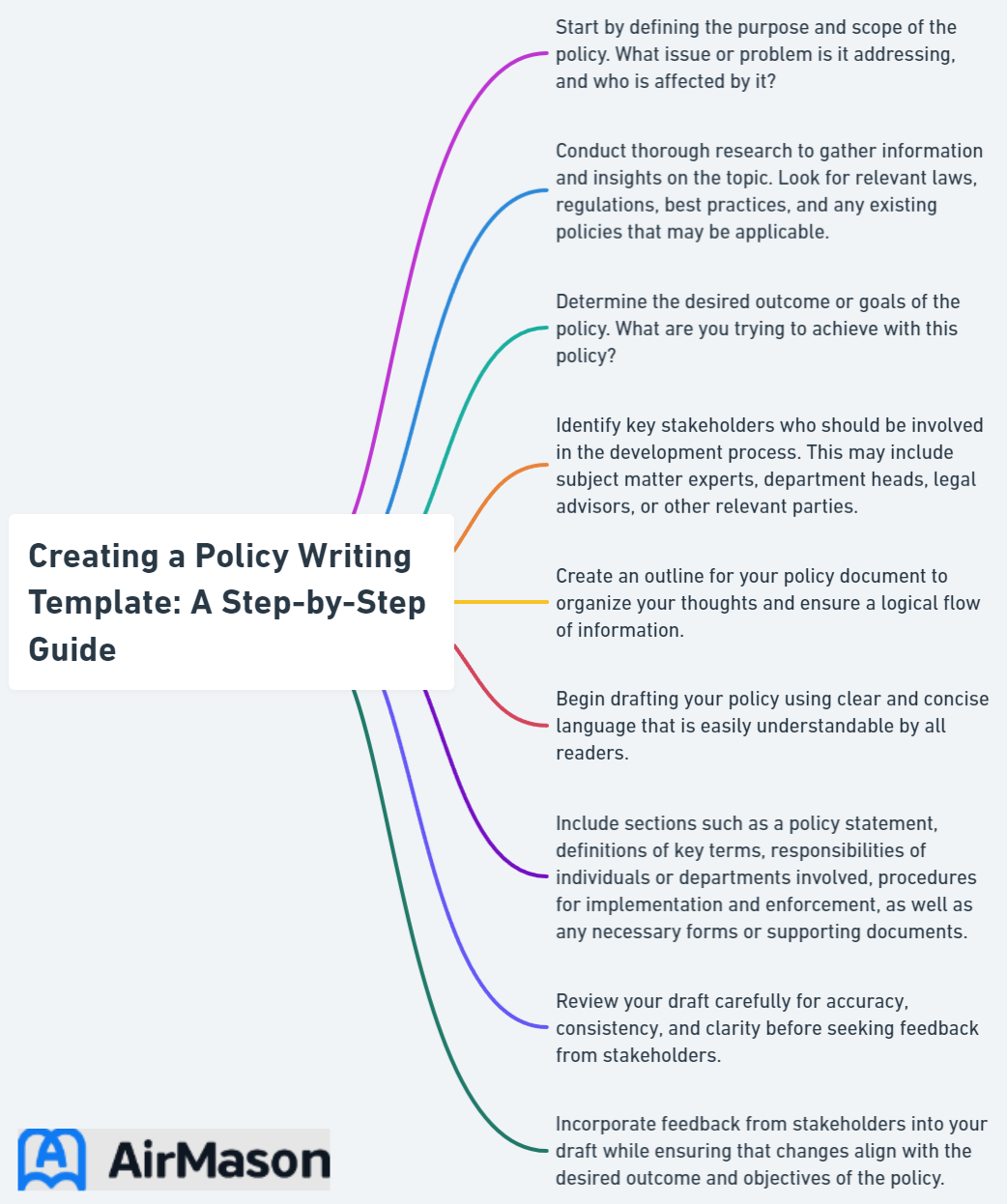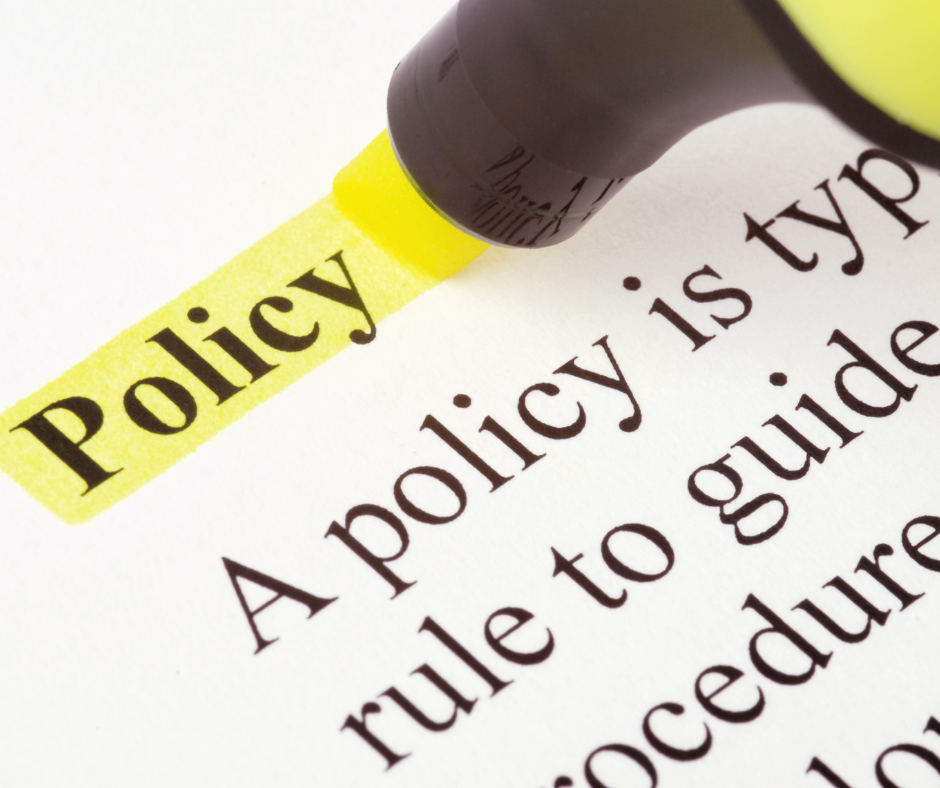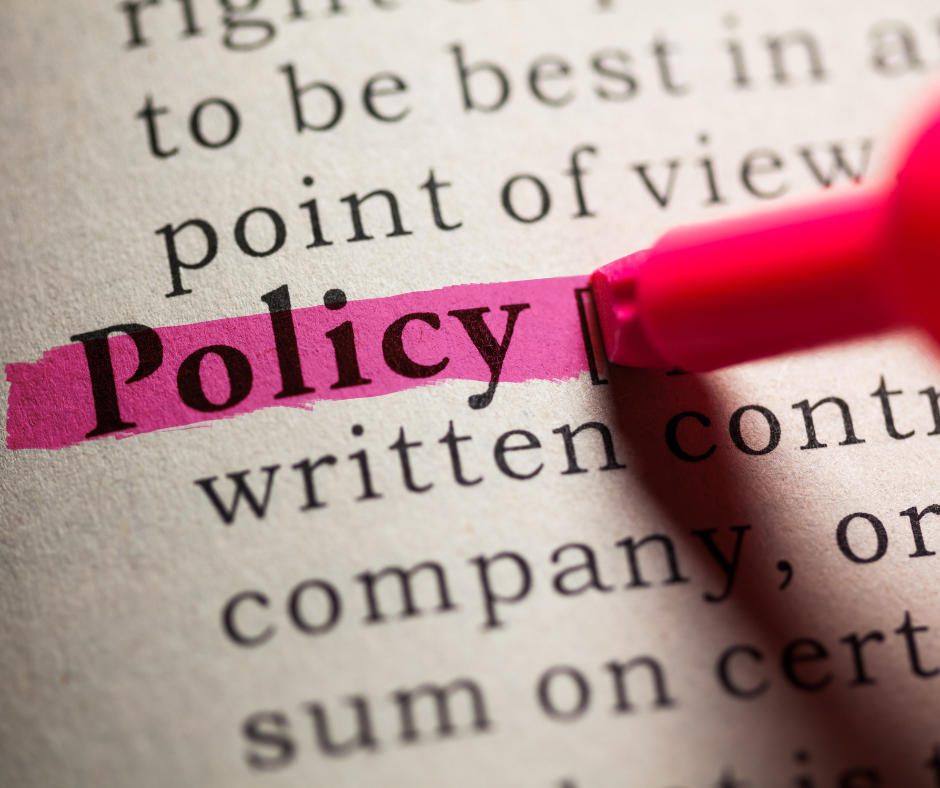
Have you ever wondered what makes an organization run smoothly and efficiently? One key factor is having clear and effective policies and procedures in place, which guide employees’ actions and decision-making. But creating well-structured policies can be a daunting task without an organized approach. In this step-by-step guide, we will explore the process of creating a comprehensive policy writing template, ensuring that your organization stays on track and compliant with regulations and best practices.
Key Takeaways
- Understand the key components of effective policies and utilize industry-specific templates to create tailored policies.
- Establish a clear title and purpose, define scope and applicability, as well as roles & responsibilities when creating policy writing templates.
- Train personnel on organizational policies for successful implementation & understanding while monitoring & reviewing regularly for compliance with regulations.
How to Write a Policy
When tackling the task of how to write a policy, it’s crucial to begin by clearly defining the purpose and scope of the policy. Start by outlining the objectives and goals that the policy aims to achieve. Consider conducting thorough research to gather relevant information and insights that will inform the content of your policy. As you delve into the writing process, ensure that the language used is clear, concise, and easily understandable by the intended audience. Additionally, it’s essential to incorporate feedback from stakeholders to ensure the policy is comprehensive and aligns with organizational values. Following these steps will help you craft a well-structured and effective policy document.
Understanding Policy Writing Templates
Policy and procedure templates serve as the foundation for creating standards and guidelines within an organization, driving the establishment of regulations and adherence to protocols. Crafting effective policies requires a strong foundation, with key components such as title and purpose, scope and applicability, and roles and responsibilities. Mastering these elements enables your organization to establish a consistent, clear framework that fosters compliance while upholding organizational values.
Industry-specific policy writing templates, such as those for healthcare or construction, can help organizations tailor their policies to the unique challenges and requirements of their sector. A firm grasp of the significance and function of policy and procedure templates empowers you to confidently tailor templates to your organization’s unique needs and culture.

The Role of Policy Templates
A policy template provides a structure for instituting regulations and directives within an organization, serving as a policy document and procedure documents. They help organizations write effective policies by offering a standardized format and approach, ensuring that all policies are consistent and easy to comprehend.
Examples of policy templates include Contractors Policy and Procedure Template, Product Management Policy and Procedure Template, and Grievance Handling Policy and Procedure Template, among many others. Utilizing these templates allows organizations to conserve time and resources, guaranteeing comprehensive and regulation-compliant policies.
The Importance of Procedure Templates
Procedure templates are equally crucial, as they outline the step-by-step processes required to implement policies and achieve consistent outcomes. By following existing procedures, employees can easily adhere to the policy as these procedures templates often include clear instructions on procedures related tasks.
In some cases, policies and procedures may be combined in the same document for ease of access and understanding. However, it is essential to maintain a clear distinction between the policy and the procedure sections within the document to avoid confusion. The procedure describes the steps to be followed, while the policy provides the overall guidance. By providing a detailed and accurate scope and applicability section, organizations can ensure that their policies are applicable to the entire organization or specific departments as needed.
Key Components of an Effective Policy Writing Template
Including key components that provide a clear policy framework is fundamental to crafting an effective policy writing template. These components include a concise title and purpose, scope and applicability, and defined roles and responsibilities. Incorporating these elements enables your organization to produce comprehensive policies that are easy to understand and effectively communicate their intent.
Each of these components plays a vital role in the development of a policy. The title and purpose communicate the policy’s objective, the scope and applicability outline its boundaries, and the roles and responsibilities section assigns accountability for implementing and enforcing the policy. Let’s delve deeper into each of these components.
Title and Purpose
A concise and clear policy title is essential for any policy, as it prevents misunderstandings and explicitly communicates the policy’s content. The title should encapsulate the overarching theme of the policy and facilitate identification for those seeking guidance on the policy’s subject matter.
The purpose of the policy should incorporate the following elements:
- Focus area
- Policy statement
- Specific goals
- Oversight
- Authority
- Responsibility
- Back-up authority
- Changes and exceptions
A clear outline of the purpose enhances the policy’s comprehensibility and interpretability, guaranteeing employees understand their roles and responsibilities, hence adhering to the policy.
Scope and Applicability
The scope and applicability of a policy define the situations and individuals to which the policy applies. This component should incorporate information that delineates the boundaries and restrictions of the policy, specifying the areas or subjects that the policy encompasses and the conditions and regulations for applying the policy.
Providing a detailed description of the policy’s scope and applicability guarantees all employees comprehend the policy’s extent and are cognizant of their responsibilities. This clarity helps guarantee that the policy is applicable to the entire organization or specific departments as needed, promoting consistency and compliance throughout.
Roles and Responsibilities
Clearly defining roles and responsibilities in a policy is crucial for ensuring that all employees understand their duties, expectations, and obligations associated with the policy. This section should outline who is responsible for implementing and enforcing the policy, providing clarity and accountability.
Explicitly stating roles and responsibilities within the policy ensures decisions are made by authorized individuals and tasks are executed efficiently. This clarity also helps employees understand their roles and what is required of them, enhancing the employee experience and promoting productivity.
Features of Policy
When exploring the intricacies of any regulatory framework, understanding the key features of policy becomes paramount. These features of policy not only serve as guiding principles but also shape the landscape within which decisions are made and actions are taken. From the clarity of objectives to the mechanisms of implementation, the features of policy encompass a broad spectrum. The comprehensiveness of a policy, its adaptability to changing circumstances, and the inclusivity of stakeholder considerations are vital aspects that contribute to its effectiveness. Analyzing and grasping the nuances of the features of policy is essential for policymakers, analysts, and citizens alike, fostering a more informed and engaged society.
Tips for Creating a Comprehensive Policy Writing Template
Creating a comprehensive policy writing template requires attention to detail and consideration of various factors, including language, consistency, and updates. Incorporating these elements allows your organization to craft an effective, easy-to-understand policy writing template that complies with relevant regulations.
Let’s explore some tips for creating a comprehensive policy writing template that can serve as a foundation for your organization’s policies and procedures.
Use Plain Language
Using plain language is crucial for ensuring that policies and procedures are easily understood by all employees, regardless of their background or expertise. Achieving this necessitates avoiding jargon, technical terms, and complex sentence structures, which can lead to misunderstandings and unacceptable behavior.
Employing plain language enhances:
- Understanding
- Transparency
- Compliance
- Time conservation
- Improving the employee experience
This approach not only ensures a clear understanding of policies but also increases their effectiveness by making them more accessible to all employees.
Maintain Consistency
Sustaining consistency in policy writing templates is imperative, as it ensures that all policies are composed in the same style and format, making them easier to comprehend and adhere to. This consistency also helps guarantee that all policies are current and accurate, ensuring compliance with applicable laws and regulations.
Developing a style guide and adhering to it throughout the policy creation process is vital for maintaining consistency in policy writing templates. This guide should include formatting elements, language, and tone, ensuring that all policies share a uniform appearance and structure.
Keep it Up-to-Date
Regularly reviewing and updating policies and procedures is vital to ensure they remain relevant and compliant with changing regulations. It is recommended to have a review cycle of at least one year, with policies being assessed and revised between one and three years.
Keeping safety policies and procedures current ensures they remain relevant to an organization’s requirements. This proactive approach helps to maintain compliance with applicable laws and regulations, ensuring that the organization remains in good standing.
Examples of Industry-Specific Policy Writing Templates

Industry-specific policy writing templates can serve as a valuable starting point for organizations looking to create customized policies that address the unique challenges and requirements of their sector. Examples of such templates include:
- IT policy writing templates
- Education policy writing templates
- Construction policy writing templates
- Small business policy writing templates
These templates provide a foundation for constructing personalized policies and procedures, allowing organizations to save time and resources while ensuring that their policies are comprehensive and compliant with industry-specific regulations. Adapting and modifying these templates enables organizations to craft customized policies that adequately cater to their unique needs and challenges.
Customizing Policy Writing Templates for Your Organization

Customizing policy writing templates for your organization involves:
- Assessing organizational needs
- Adapting templates to fit company culture
- Ensuring that your organization’s policies are in line with its specific requirements, culture, and objectives.
This process ensures that your organization’s policies are tailored to meet its unique needs and goals.
Personalizing templates ensures the resulting policies are applicable, clear, and effective in addressing an organization’s unique predicaments and objectives. This customization also contributes to the establishment of uniformity and adherence within the organization, in addition to improving employee comprehension and acceptance of the policies.
Assessing Organizational Needs
Determining which policies and procedures are necessary for an organization requires a thorough understanding of its specific needs and industry context. By outlining goals and objectives, organizations can create policies and procedures that provide guidelines, standards, and processes that align with their strategic direction.
Assessing organizational needs helps ensure that employees’ actions and decisions align with the overall goals and objectives, fostering consistency, efficiency, and accountability. This process aids in the development of tailored policies and procedures that effectively address the organization’s unique challenges and opportunities.
Adapting Templates to Fit Company Culture
Adapting policy writing templates to fit company culture involves:
- Understanding the company culture
- Customizing language and tone
- Aligning policies with company values
- Incorporating company-specific examples
- Involving key stakeholders
By following these steps, organizations can create policies that are relevant and effective.
Aligning policy templates with company values helps foster a unified and consistent culture that employees can identify with and comply with. This process ensures that the policies and procedures are not only effective in resolving organizational challenges but also promote a positive and cohesive work environment.
Implementing and Maintaining Your Policy Writing Template

Implementing and maintaining a policy writing template involves two key steps: training and communication, and monitoring and reviewing the effectiveness of policies and procedures. This process is essential for ensuring that employees are aware of new policies and procedures and that the organization remains compliant with applicable regulations.
Following a systematic approach to implementing and maintaining policy writing templates ensures that those who write policies remain effective, current, and align with industry best practices.
Training and Communication

Training employees on new policies and procedures and communicating any updates or changes are crucial for ensuring that all personnel understand and adhere to the policies. Effective training techniques include documenting the company’s procedures, consistently enforcing policies and procedures, and providing regular training sessions.
Internal communication plays a vital role in policy implementation, as it facilitates an efficient exchange of information within the organization and informs staff of new policies, regulations, and processes. Providing clear and concise training and communication ensures effective implementation and adherence to policies by all employees.
Monitoring and Reviewing

Regularly monitoring and reviewing the effectiveness of policies and procedures is essential for maintaining compliance and efficiency within the organization. This process involves:
- Assessing the results
- Gathering feedback
- Analyzing data and evidence
- Performing regular reviews of policies and procedures.
Maintaining a proactive approach to monitoring and reviewing policies helps identify areas for improvement and make necessary adjustments to ensure compliance with applicable laws and regulations. This ongoing process ensures that policies remain current, accurate, and effective in addressing the organization’s specific needs and challenges.
Policy Numbering Best Practices
When it comes to managing policies efficiently, implementing solid policy numbering best practices is paramount. Assigning clear and structured policy numbers not only streamlines document organization but also enhances accessibility for stakeholders. Utilizing a standardized numbering system ensures consistency, making it easier to track revisions and updates. Moreover, incorporating alphanumeric codes or specific prefixes can provide additional insights into the nature or category of policies. By adhering to these policy numbering best practices, organizations can establish a robust foundation for effective policy management, fostering clarity and compliance across the board.
Summary
In conclusion, creating a comprehensive policy writing template is an essential step in ensuring that your organization is well-equipped to navigate the complexities of compliance, industry regulations, and internal processes. By following this step-by-step guide, you can develop policy writing templates that are clear, consistent, and aligned with your organization’s unique needs and culture. By prioritizing training, communication, and regular monitoring and reviewing, you can ensure the ongoing effectiveness of your policies and maintain a strong foundation for your organization’s success.
Frequently Asked Questions
What is the format for writing a policy?
The format for writing a policy includes beginning with a concise policy statement, providing definitions for specific terms and concepts, and presenting the policy content in a logical and organized manner. Additionally, a formal tone should be used throughout.
How do you start writing a policy?
To start writing a policy, define the purpose and scope of the policy, identify responsibilities and procedures, create a standard template, and begin drafting the policy using plain language in a relevant and enforceable way.
What are the 8 main components of a policy document?
A policy document typically consists of the header block, backdrop, purpose, scope, definitions, policy statements, processes, linked policies and references.
What are the 4 components to make a policy?
Creating a policy requires a clear statement of the purpose, scope, definitions, procedures and accountability measures. Additionally, an effective policy must address monitoring and enforcement as well as regular review and updating.
Why is using plain language important in policy writing templates?
Using plain language makes policies and procedures easily understandable for everyone, creating greater understanding, transparency, and compliance.